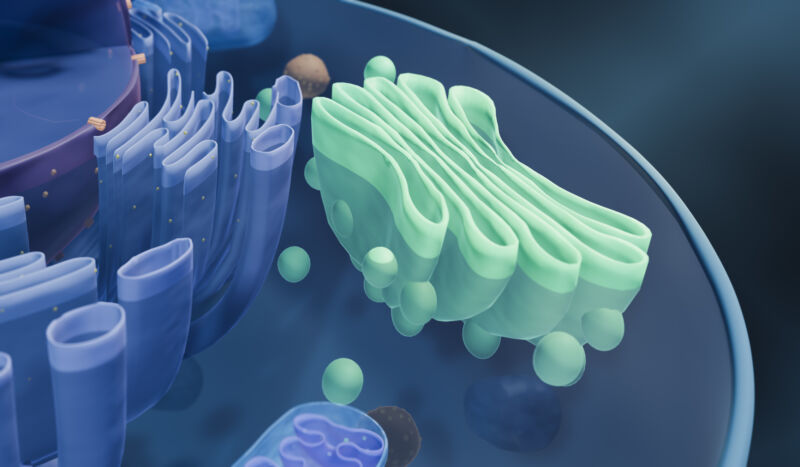Going Golgi —
Specialized internal structures were present over 1.5 billion years ago.

Enlarge / The Golgi apparatus, shown here in light green, may have been involved in building internal structures in cells.
ARTUR PLAWGO / SCIENCE PHOTO LIBRARY
Before Neanderthals and Denisovans, before vaguely humanoid primates, proto-mammals, or fish that crawled out of the ocean to become the first terrestrial animals, our earliest ancestors were microbes.
More complex organisms like ourselves descend from eukaryotes, which have a nuclear membrane around their DNA (as opposed to prokaryotes, which don’t). Eukaryotes were thought to have evolved a few billion years ago, during the late Palaeoproterozoic period, and started diversifying by around 800 million years ago. Their diversification was not well understood. Now, a team of researchers led by UC Santa Barbara paleontologist Leigh Ann Riedman discovered eukaryote microfossils that are 1.64 billion years old, yet had already diversified and had surprisingly sophisticated features.
“High levels of eukaryotic species richness and morphological disparity suggest that although late Palaeoproterozoic [fossils] preserve our oldest record of eukaryotes, the eukaryotic clade has a much deeper history,” Riedman and her team said in a study recently published in Papers in Paleontology.
Really, really, really old tricks
During the late Palaeoproterozoic, eukaryotes most likely evolved in the wake of several major changes on Earth, including a drastic increase in atmospheric oxygen and shifts in ocean chemistry. This could have been anywhere from 3 billion to 2.3 billion years ago. Riedman’s team explored the layers of sedimentary rock in the Limbunya region of Australia’s Birrindudu basin. The fossils they unearthed included a total of 26 taxa, as well as 10 species that had not been described before. One of them is Limbunyasphaera operculata, a species of the new genus Limbunyasphera.
What makes L. operculata so distinct is that it has a feature that appears to be evidence of a survival mechanism used by modern eukaryotes. There are some extant microbes that form a protective cyst so they can make it through harsh conditions. When things are more tolerable, they produce an enzyme that dissolves a part of the cyst wall into an opening, or pylome, that makes it possible for them to creep out. This opening also has a lid, or operculum. These were both observed in L. operculata.
While splits in fossilized single-cell organisms may be the result of taphonomic processes that break the cell wall, complex structures such as a pylome and operculum are not found in prokaryotic organisms, and therefore suggest that a species must be eukaryotic.
Didn’t know they could do that
Some of the previously known species of extinct eukaryotes also surprised the scientists with unexpectedly advanced features. Satka favosa had a vesicle in the cell that was enclosed by a membrane with platelike structures. Another species, Birrindudutuba brigandinia, also had plates identified around its vesicles, although none of its plates were as diverse in shape as those seen in different S. favosa individuals. Those plates came in a large variety of shapes and sizes, which could mean that what has been termed S. favosa is more than one species.
The plated vesicle of S. favosa is what led Riedman to determine that the species must have been eukaryotic, because the plates are possible indicators that Golgi bodies existed in these organisms. After the endoplasmic reticulum of a cell synthesizes proteins and lipids, Golgi bodies process and package those substances depending on where they have to go next. Riedman and her team think that Golgi or Golgi-like bodies transported materials within the cell to form plates around vesicles, such as the ones seen in S. favosa. The hypothetical Golgi bodies themselves are not thought to have had these plates.
This sort of complex sorting of cellular contents is a feature of all modern eukaryotes. “Taxa including Satka favosa… are considered [eukaryotes] because they have a complex, platy vesicle construction,” the researchers said in the study. These new fossils suggest that it arose pretty early in their history.
Eukaryotes have evidently been much more complex and diverse than we thought for hundreds of millions of years longer than we thought. There might be even older samples out there. While fossil evidence of eukaryotes from near their origin eludes us, samples upwards of a billion years old, such as those found by Riedman and her team, are telling us more than ever about their—and therefore our—evolution.
Papers in Paleontology, 2023. DOI: 10.1002/spp2.1538